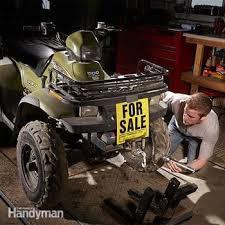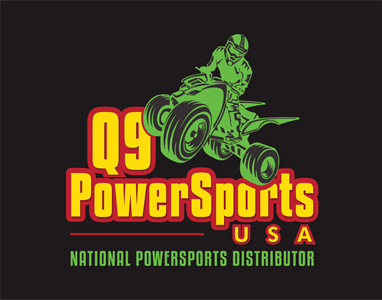
Buying a Used ATV: What to Look for and How to Avoid Getting Ripped Off
Jeremy KuehniShare
A Comprehensive Guide to Buying a Used ATV: What to Look for and How to Avoid Getting Ripped Off
The thrill of riding an ATV through rugged terrain, dense forests, or open trails is undeniable. Whether you're looking to conquer challenging trails, explore hidden backroads, or simply enjoy a leisurely ride through nature, an ATV offers an exhilarating experience. However, buying a new ATV can be a hefty investment, often exceeding the budget of many enthusiasts. This is where the used ATV market comes into play, offering a fantastic opportunity to experience the joy of off-roading at a more affordable price.
The used ATV market is filled with a diverse range of models, from reliable workhorses to high-performance machines. But navigating this market requires caution and a keen eye for detail to ensure you're getting a reliable machine, not a money pit. This comprehensive guide will walk you through the essential things to look for when buying a used ATV, helping you make an informed decision and avoid potential pitfalls. We'll delve into the critical aspects of inspecting the ATV, understanding its history, and negotiating a fair price, empowering you to make a smart and satisfying purchase.
Assessing the ATV's Condition: A Step-by-Step Inspection
The first step in your used ATV buying journey is to thoroughly inspect the machine for any signs of wear, tear, or potential problems. This involves a combination of visual inspection, a test ride, and understanding the ATV's history. Let's break down the key areas to examine:
Engine: The Heart of the Machine
The engine is the most crucial component of an ATV, responsible for its power and performance. A thorough engine inspection can reveal potential issues that could lead to costly repairs down the line. Here's what to look for:
1. **Start it Up and Listen Closely:** The first step is to start the engine and listen carefully for any unusual sounds. Common red flags include:
- Rattling: This could indicate loose engine components, worn bearings, or issues with the valve train.
- Knocking: This often points to problems with connecting rods, pistons, or the crankshaft.
- Grinding: A grinding sound suggests problems with gears, bearings, or other moving parts within the engine.
- High-Pitched Whine: This might indicate issues with the timing chain, water pump, or other rotating components.
2. **Check for Leaks:** Look for signs of oil leaks around the engine block, valve covers, oil filter, and other seals. Leaks can indicate worn seals, cracked components, or overtightened bolts. Also, check the coolant reservoir for leaks and ensure the level is adequate.
3. **Oil Condition:** Check the oil level on the dipstick. If the oil is black, gritty, or smells burnt, it indicates neglect and potential engine wear. The oil should be clean and have a light amber color.
4. **Exhaust Smoke:** Observe the exhaust smoke. Blue smoke could indicate worn piston rings or valve seals, allowing oil to burn in the combustion chamber. Black smoke might signal a rich fuel mixture or issues with the fuel injectors. White smoke usually indicates a coolant leak into the combustion chamber.
Transmission and Drivetrain: Ensuring Smooth Power Transfer
The transmission and drivetrain are responsible for transferring power from the engine to the wheels, enabling the ATV to move. Inspect these components to ensure they are in good working order.
1. **Shifting Smoothness:** Shift through all gears, ensuring they engage smoothly without grinding or slipping. If the shifting is rough or erratic, it could indicate worn transmission components, misadjusted cables, or internal problems.
2. **Clutch Feel:** Engage the clutch and check for a smooth, consistent feel. A slipping or spongy clutch can indicate worn clutch plates, a faulty hydraulic system, or a problem with the clutch cable.
3. **Drivetrain Check:** Inspect the drive shaft, axles, and universal joints for any signs of wear, damage, or leaks. These components are subjected to significant stress during off-road riding, so signs of wear are a cause for concern.
Suspension and Steering: Maintaining Control and Comfort
A well-functioning suspension system is crucial for a smooth and comfortable ride, while precise steering provides control over the ATV. Here's how to assess these components:
1. **Shock Inspection:** Inspect the shocks for leaks or excessive wear. Look for any cracks or damage to the shock bodies or mounting points. Leaks can indicate worn seals or internal problems, while cracks or damage suggest potential failure.
2. **Steering Feel:** Turn the handlebars from lock to lock, checking for any binding, excessive play, or uneven steering resistance. Binding indicates potential issues with the steering stem, bearings, or other components. Excessive play can be a sign of worn steering bearings or loose steering components.
3. **Tire Condition:** Examine the tires for tread depth and signs of uneven wear. Check the sidewalls for any bulges, cracks, or damage. Tires with insufficient tread depth or visible damage can compromise traction, handling, and safety.
4. **Wheel Bearings:** Gently shake the wheels to check for play in the bearings. Any excessive play indicates worn bearings that may require replacement.
Brakes and Electrical System: Ensuring Safe and Reliable Operation
The brakes are essential for stopping safely, while a reliable electrical system ensures proper functioning of lights, signals, and other electrical components.
1. **Brake Pads:** Inspect the brake pads for wear and tear. Ensure they have adequate thickness and aren't cracked or glazed. Worn brake pads can compromise stopping power and may lead to damage to the rotors.
2. **Brake Rotors:** Look for any grooves, warping, or rust on the brake rotors. These can affect braking performance and may indicate the need for replacement.
3. **Brake Lines:** Check the brake lines for leaks, damage, or signs of corrosion. Leaks can cause brake failure, while damaged or corroded lines pose a safety risk.
4. **Lights and Signals:** Test all lights, turn signals, and horn to ensure they are functioning correctly.
5. **Battery:** Check the battery terminals for corrosion and ensure the battery is securely mounted.
6. **Electrical Components:** Look for any frayed wires, loose connections, or signs of melted wiring. These can indicate electrical problems that need addressing.
Body and Accessories: Assessing Aesthetics and Functionality
While the condition of the bodywork and accessories may not directly affect the ATV's performance, they can indicate the level of care and maintenance the ATV has received.
1. **Body Damage:** Inspect the bodywork for any scratches, dents, or cracks. Look for signs of previous repairs that may not have been done correctly. Significant body damage can be an indicator of the ATV's overall condition and potentially hidden issues.
2. **Frame Inspection:** Check the frame for any signs of bending, twisting, or cracking. The frame is the backbone of the ATV, and damage to it can compromise its structural integrity and safety.
3. **Accessories:** If the ATV comes with accessories, like a winch, plow, or cargo box, inspect them for functionality and condition. Ensure they are in good working order and that any attachments are securely mounted.
History and Maintenance Records: Understanding the ATV's Past
Knowing the history of a used ATV can provide valuable insights into its condition, maintenance practices, and potential future expenses.
1. **Maintenance Records:** Ask the seller for maintenance records, if available. These records will give you insights into the ATV's history, how it has been maintained, and any major repairs performed.
2. **Previous Owners:** If possible, inquire about the number of previous owners and their reasons for selling. A high number of owners or vague reasons for selling could be red flags.
3. **Ownership History:** Check the ATV's title and registration for any inconsistencies or red flags. These documents can help you verify the ATV's ownership and identify any potential legal issues.
Test Ride and Final Evaluation: A Hands-On Assessment
After a thorough visual inspection, the next step is to take the ATV for a test ride. This allows you to experience the ATV's performance firsthand and assess its overall condition.
1. **Test Ride:** Always take a test ride before committing to a purchase. Drive the ATV on different surfaces, including rough terrain, to get a feel for its handling, power, and braking performance.
2. **Listen for Sounds:** Pay attention to any unusual sounds or vibrations during the test ride. These could be signs of underlying problems that weren't apparent during the visual inspection.
3. **Evaluate Performance:** Gauge the ATV's acceleration, braking, and overall performance. Does it meet your expectations? Is the power delivery smooth and consistent? Does the ATV handle well on various terrains?
4. **Overall Condition:** Consider the ATV's overall condition and how it compares to other similar models in the market. Is it well-maintained, clean, and free from excessive wear and tear?
Tips for Negotiating a Fair Price: Getting the Best Deal
Once you've thoroughly inspected the ATV and are satisfied with its condition, it's time to negotiate a fair price with the seller. Here are some strategies to help you get the best deal:
1. **Research Comparable Models:** Do your research on the average price of similar used ATVs in your area. Use online resources like Craigslist, Facebook Marketplace, ATV forums, and websites that specialize in used vehicle pricing to get an idea of market value.
2. **Be Prepared to Walk Away:** Don't be afraid to walk away from a deal if the price is too high or the ATV isn't what you're looking for. Remember, there are other ATVs out there, and you shouldn't settle for a purchase that makes you uncomfortable.
3. **Negotiate:** Once you've determined a fair price, be prepared to negotiate with the seller. Don't be afraid to make a counteroffer, especially if you've identified any potential issues with the ATV or if the seller's asking price is significantly higher than market value.
4. **Consider Potential Costs:** Factor in potential repair costs when negotiating the price. If the ATV needs repairs, you may want to ask for a lower price to cover those expenses.
Additional Considerations: Making a Wise Investment
Before you finalize your purchase, consider these additional factors to ensure a smooth and enjoyable ownership experience:
1. **Insurance:** Check the cost of ATV insurance in your area. Insurance can provide financial protection in case of accidents, theft, or damage.
2. **Safety Gear:** Make sure you have all the necessary safety gear, including a helmet, gloves, boots, and protective clothing. Safety should always be a top priority when riding an ATV.
3. **Legal Requirements:** Familiarize yourself with the local laws and regulations regarding ATV operation. This includes licensing requirements, registration, and designated riding areas.
Conclusion: Enjoying the Thrill of Off-Road Adventures
Buying a used ATV can be a rewarding experience, allowing you to enjoy off-road adventures without breaking the bank. By following these tips, you can increase your chances of finding a reliable, safe, and affordable ATV that meets your needs and budget. Remember to be thorough in your inspection, don't be afraid to ask questions, and always prioritize safety. Happy riding!
